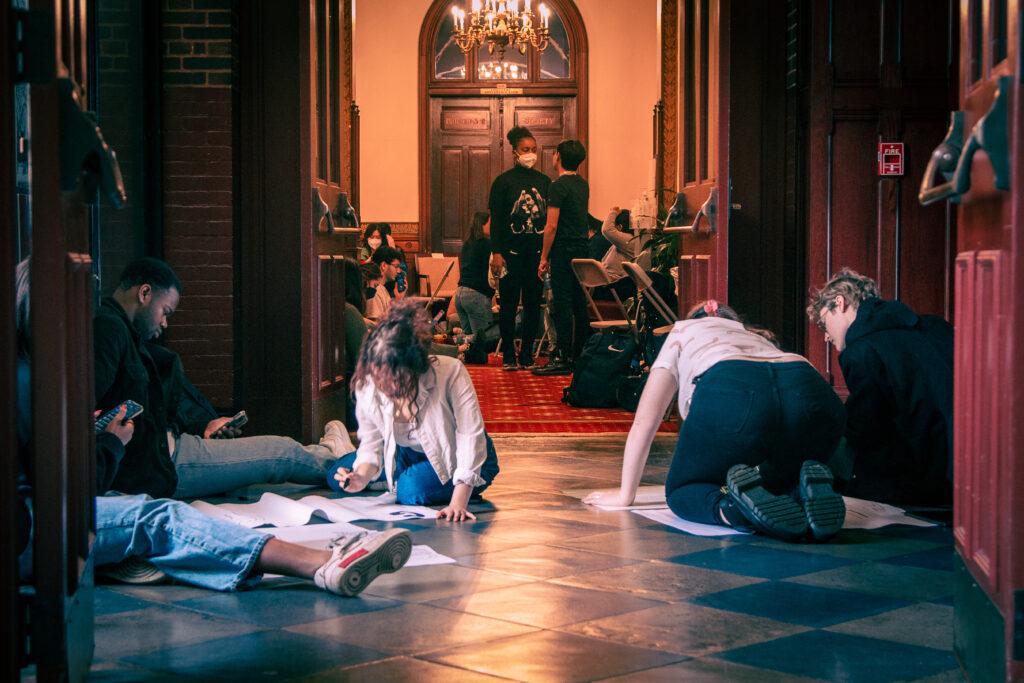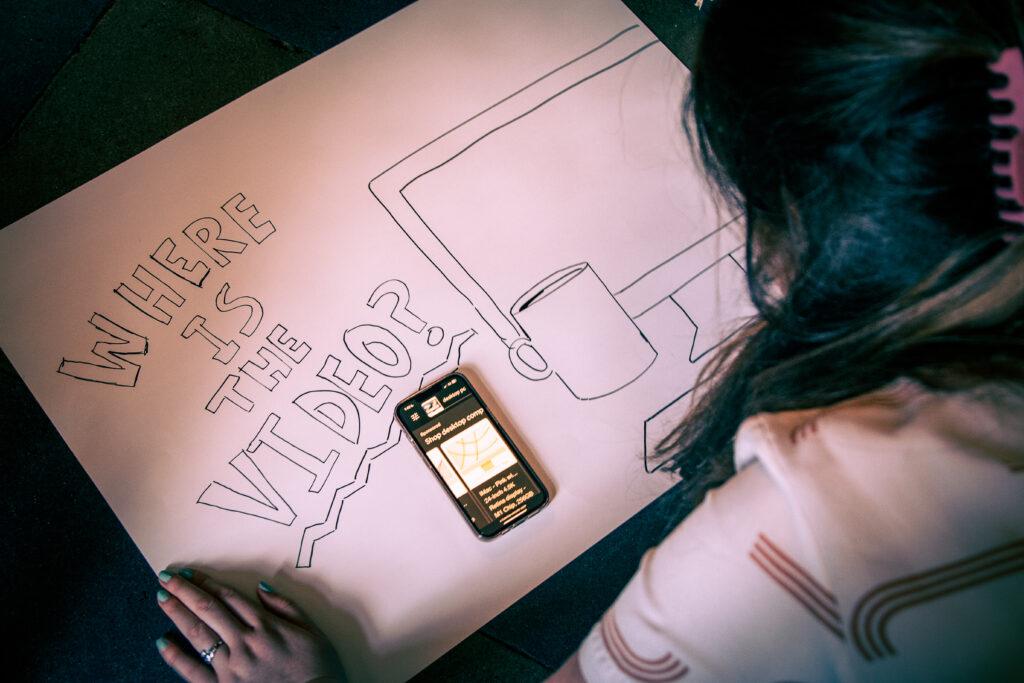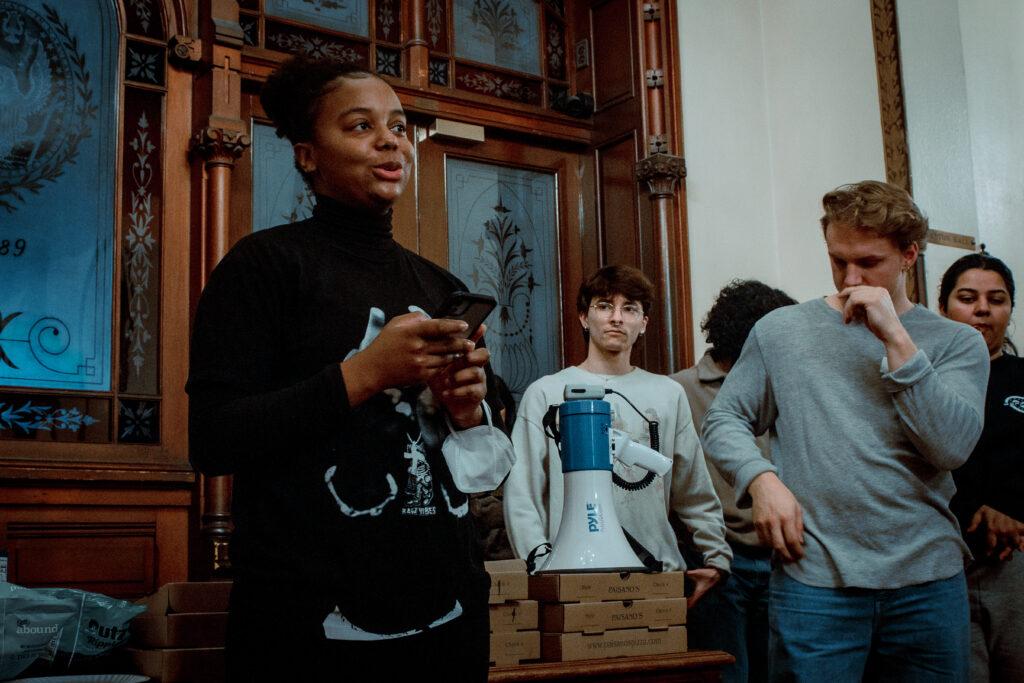CW: This article references/discusses racism and hate speech. Please refer to the end of the article for on- and off-campus resources.
Editor’s Note: See a detailed timeline of events leading up to the Feb. 8 sit-ins embedded in the article, or at this link.
Students reignited sit-in protests this week, gathering in Healy Hall to demand justice for LaHannah Giles (CAS ’23) and for the university to expel the student who committed a hate crime against them nearly a year ago.
On April 29, Georgetown Day, a white male student called for the death of all Black people and shouted racial slurs at Giles, who is Black, from the window of New South Hall, a first-year dorm. Following the hate crime, Giles said they and five eyewitnesses identified the perpetrator from screenshots of security camera footage and GOCard data during a university investigation, but the university failed to take disciplinary action against the student or inform the Georgetown community of the hate crime.
Sit-in protests first took place from Dec. 5 to 8, pushing the university to acknowledge the hate crime and expel the perpetrator. The protests resumed on Wednesday following the conclusion of the Office of Institutional Diversity, Equity & Affirmative Action’s (IDEAA) ten-month investigation of the hate crime, which yielded inconclusive results Feb. 7.
In their report, which Giles said the university prohibited them from sharing publicly, IDEAA claims there was insufficient evidence to determine the perpetrator, even though Giles said they identified the student.
“I don’t think any words can ever describe how I felt after receiving the investigation results yesterday,” Giles said at the Feb. 8 sit-in. “Just like I was denied justice 10 months ago, I am now being denied justice once again today, this time with a stinging sense of finality.”
A university spokesperson said IDEAA applied its “preponderance of the evidence” standard and was unable to identify the perpetrator — meaning IDEAA could not say if any suspects were more likely than not responsible for the hate crime.
“Investigators carefully reviewed all submitted evidence and interviewed witnesses and potential suspects, including new evidence that was submitted and new witnesses who were identified in December, late January and early February,” the spokesperson wrote to The Hoya.
Evidence included security footage, photographs, GOCard swipes, testimonial evidence and documents provided by suspects and witnesses, according to the spokesperson.
Hundreds of students filtered through the sit-in organized by Georgetown University Protects Racists (GUPR), a group of student activists demanding justice for Giles, from 9 a.m. to 5 p.m. and participated in chants every hour, including “Justice for LaHannah,” “Expel the Racist Student” and “No Justice, No Peace.”
Giles and other GUPR leaders organized the original sit-ins to demand accountability and acknowledgement from the university about the hate crime.
“Shame on the entire institution of Georgetown, for constantly failing its marginalized communities, but especially its Black students — Black women in particular,” Giles said. “It is not on Black students to dismantle this university’s legacy of white supremacy; it is this institution’s job.”
The Second Round of Sit-Ins
In their 1 p.m. address at the Feb. 8 sit-in, Giles shared updates while surrounded by a crowd of supporters from the campus community.
“I want to know that you’ve deeply touched me by being here today,” Giles said. “I want to be vulnerable because I know that vulnerability is really important, and you have consistently showed up, and the least I can do is show back up by letting you know what’s really happening.”
GUPR’s short-term goals for the sit-ins are the expulsion of the perpetrator and spreading awareness about the university’s handling of the hate crime, according to GUPR organizer Sanchi Rohira (SFS ’24).

“One of the most prestigious and prominent universities in the country in 2023 spearheaded the cover-up of a racist hate crime committed against a Black woman 10 months ago on its campus,” Rohira said in an interview with The Hoya.
“We want prospective students, especially prospective students of color, to know what they’re getting into when they decide to apply to Georgetown University. We want parents sitting at home to know what safety means at Georgetown and how the administration is actively cultivating an unsafe environment for students of color,” Rohira added.
Alex Missen (SFS ’24) attended the Feb. 8 sit-in and said the Georgetown University Police Department (GUPD) and the university’s handling of the hate crime investigation is unacceptable.
“If we don’t hold them accountable now, when are they ever going to be held accountable?” Missen told The Hoya. “It seems like they’re just shutting the door on this case and giving a half satisfactory answer in the hopes that that’s what we’re going to accept. Clearly, that isn’t the case.”
Kennedy Jackson (SFS ’25) came to the protest to support Giles and assisted with making posters that students put up on the walls of Healy Hall and other prominent locations on campus reading “We Demand Justice,” “Healy Hall is Occupied” and “We Love LaHannah,” among other messages.
“It could be anyone that this happened to, any Black person on campus, and that’s really scary,” Jackson said in an interview with The Hoya. “I believe it’s really important, especially as a Black woman, for me to support.”
Dozens of student groups have shown solidarity with Giles and the sit-ins, including the Georgetown Black Student Alliance, the Georgetown University Black Leadership Forum, GU Pride, H*yas for Choice, the Asian American Student Association, Georgetown University College Democrats, the South Asian Society, The Corp and the Georgetown University Student Associations, among others.
How did this happen?
Immediately after the hate crime, Giles’ friends who witnessed the crime called GUPD to report it, and later that night, Giles filed a crime report with GUPD and a bias-related incident report through the university’s bias reporting system. The university, however, failed to reach out to Giles about their report until May 6, a week after the hate crime occurred, according to Giles’ Nov. 30 press release.
In the days following the hate crime, GUPD created a report identifying two potential suspects that matched Giles’ description of the perpetrator and were recorded using a GOCard swipe into New South, the building the perpetrator was in at the time of the incident.
The report included images of these suspects taken from GUPD security camera footage, and Giles and five eyewitnesses pointed to one of them as being the perpetrator, multiple sources told The Hoya. Both suspects denied all involvement with the hate crime when university officials contacted them.
On May 13, Giles met with Judy Johnson, the director of the Office of Student Conduct, and the assistant director, Victor Lopez. Johnson told Giles IDEAA would be taking over their case, and Giles said she proceeded to berate them for their reaction to the hate crime.
“Johnson essentially told me I did not deserve to feel the way I did about the hate crime,” Giles wrote in their Nov. 30 press release. “Johnson betrayed, gaslit, and violated me. I felt unseen and unbelieved.”
Johnson did not respond to The Hoya’s request to comment in time for publication. Additionally, the university did not respond to The Hoya directly about these claims.
“While we cannot comment on matters involving individual students or incidents, the philosophy guiding the Office of Student Conduct is educational and grounded in our community’s mission and values,” a university spokesperson wrote on behalf of the Office of Student Conduct. “We seek to understand the impact that campus life experiences have on students, as we do the work of evaluating and adjudicating potential violations of the Code of Student Conduct.”
In the weeks following the hate crime, the Office of Student Conduct asked GUPD for the footage Giles used to identify the perpetrator. The university then discovered that GUPD had lost all footage related to the hate crime after an alleged server failure, meaning Giles had no video evidence of the student they identified as the perpetrator.
IDEAA told Giles the footage was lost, and that without video evidence and because the student denied all personal involvement, the student could not be held accountable. This was despite Giles previously identifying the student when footage was available and from still photographs GUPD took of the footage before it was lost.
A university spokesperson did not comment when The Hoya asked what date GUPD’s servers failed and when they installed new servers.
The university took no public action in the following six months.
“The Georgetown University administration and GUPD refuse to acknowledge the hate crime that happened to me, so I will make them,” Giles wrote in a Nov. 30 press release. “No justice, no peace.”
During that time, Giles said they experienced intense emotional distress because of the hate crime and felt invalidated by university administration.
“For close to seven months now I have been in therapy dealing with the aftermaths of being racially harassed by a racist violent white peer. I’m traumatized,” Giles wrote in the caption of their Nov. 22 Instagram post. “Please Georgetown do something.”
Giles went public about the hate crime and their subsequent experience with Georgetown administration Nov. 22, posting an Instagram infographic that garnered over 13,000 likes.
In early December, the first round of sit-ins began, leading to the university publicly apologizing, GUPD reclassifying the incident as a hate crime and IDEAA starting a new hate crime investigation.
Giles and GUPR organizers met with university officials multiple times to discuss ways for the university to meet their demands, including an internal published review of IDEAA, the Student Office of Conduct and GUPD’s handling of Giles’ case. They additionally suggested IDEAA change its investigation policy to include testimonial evidence and increasing support for Black students on campus.
The university finally acknowledged the hate crime to the campus community in a Dec. 8 university-wide email. Officials also committed to sending out emails every time a hate crime occurred on campus going forward.
The IDEAA Investigation Report
After GUPR said the university did not share the IDEAA investigation report with Giles on Dec. 17, Jan. 13 or Jan. 31, GUPR emailed IDEAA on Feb. 1 informing them of their intent to restart sit-in protests if they did not share the report by Feb. 7. According to a university spokesperson, the university had not promised to conclude the investigation by the December or January dates.
A university spokesperson said new witnesses were identified in December, late January and early February.
“The incident was thoroughly investigated by the Office of Institutional Diversity, Equity, and Affirmative Action (IDEAA) and the Georgetown University Police Department (GUPD),” the spokesperson wrote. “The evidence that was reviewed included security footage, photographs, and GOCard swipes, as well as testimonial evidence and documents provided by witnesses and potential suspects.”

On Feb. 7, the results of IDEAA’s investigation came back inconclusive, with the report stating that there was insufficient evidence to determine the perpetrator, despite Giles identifying the student.
“I hoped that I would have a sense of relief and closure, contributing to the ending of the protests. However, instead, I received an overall feeling of hurt, disappointment, invisibility and disbelief,” Giles said at the Feb. 8 sit-in. “The investigation report outlined that based on the evidence available, the student I have identified and know is the person responsible for the hate crime will not be held accountable because the evidence isn’t sufficient enough — the evidence they have lost.”
GUPR organizer AK (SFS ’23) said they believe it was not coincidental IDEAA met this final deadline after learning of the possibility of future sit-ins
“This looks like it’s an act to silence LaHannah and to put an end to the protests, especially with how they strategically met our deadline without actually delivering any justice,” AK told The Hoya. “We want to keep asking for justice for LaHannah, and that does mean continuing to ask for the identity of this suspect to be released and for their expulsion process to begin.”
It is particularly upsetting that IDEAA was the university office that produced these results, Rohira said.
“The Office of Institutional Diversity, Equity and Affirmative Action is the office that ultimately participated in and continued the cover-up of a racist hate crime that happened at Georgetown,” Rohira said.
“There are two primary offices that participated in this hate crime, and one of them was the Georgetown Police Department — which we all knew was coming because it’s a police department,” Rohira said. “The more surprising office that participated in this cover up was the office that is tasked with protecting the interests of and the security of students of color on campus.”
What now?
In light of the report’s inconclusive results, GUPR organizers said they are shifting their focus from the perpetrator to the university and the institutions they said spearheaded a cover-up of the hate crime. As such, sit-ins came to a close Feb. 10.
“Moving forward, our protest is going to take different forms,” Rohira said at a GUPR community meeting Feb. 10. “For the purpose of our work, and our student organizing, it makes sense now to try to reimagine what justice looks like. It’s our responsibility to make sure that as many people as possible who might be considering Georgetown know what happened here.”
From holding monthly community meetings to partnering with student organizations to spread awareness about the university’s handling of the hate crime, GUPR organizers said their goal is to target the university’s image and its donor funding.
“Money and reputation are the only two languages that this school understands,” Rohira said at the protest. “The president’s office might not be the best target for our actions anymore given that they clearly decided what they want to do, and we’re gonna have to show them what they did in a way that they understand a little bit better than us just sitting here.”
Giles told community members they would be stepping back from an organizational role at GUPR to focus on their health, making GUPR an entirely community-led effort.
“The entire system of Georgetown, the institution itself, must be dismantled from the bottom up, and that starts with setting a precedent that we as a community will not allow Georgetown to get away with covering up the hate crime that’s happening to me,” Giles said. “I call on you to continue showing up to demand justice on my behalf.”
The university created three work groups Feb. 6 to implement the commitments they made to Giles and the Georgetown community in December. These groups will focus on prioritizing access to communal spaces for underserved communities, including the Black Student Alliance, to meet; launching a funding process for the Students of Color Alliance, a collaboration of leaders of cultural organizations on campus; and reviewing the bias reporting system.
Giles encouraged students to invite their friends and classmates to attend future GUPR programming.
“I give you the baton to continue to demand justice for me from Georgetown,” Giles said. “I have done all I can, and I call you to do all you can.”
Correction: This article was updated Feb. 10 to correct the length of the IDEAA investigation from two months to 10 months. This article was further updated Feb. 13 to to reflect that the university did not officially commit to release the IDEAA report on Dec. 17, 2022, Jan. 13 and then Jan. 31 on paper. This article has also been updated to reflect who provided the claim that five eyewitnesses corroborated Giles’ identification of the perpetrator.
Update: This article was updated Feb. 10 to reflect new advancements in GUPR’s programming and the end of sit-in protests.
Resources: On-campus resources include Health Education Services (202-687-8949) and Counseling and Psychiatric Service (202-687-7080); to report an incident of hate or bias on campus, refer to the Georgetown University Bias Reporting website. Off-campus resources include the Metropolitan Police Department (MPD). In the event of an emergency, dial 911. To report a hate crime, contact the MPD Hate Crimes Voicemail (202) 727-0500 or the Hate Crimes Coordinator ([email protected]).
















Marina • Feb 11, 2023 at 3:43 pm
This is not something that should still be occurring in such a renowned institution, students should have the basic privilege of feeling safe and heard in their school. Well-written, unbiased journalism like this matters. No more turning a blind eye to racism for the sake of convenience.